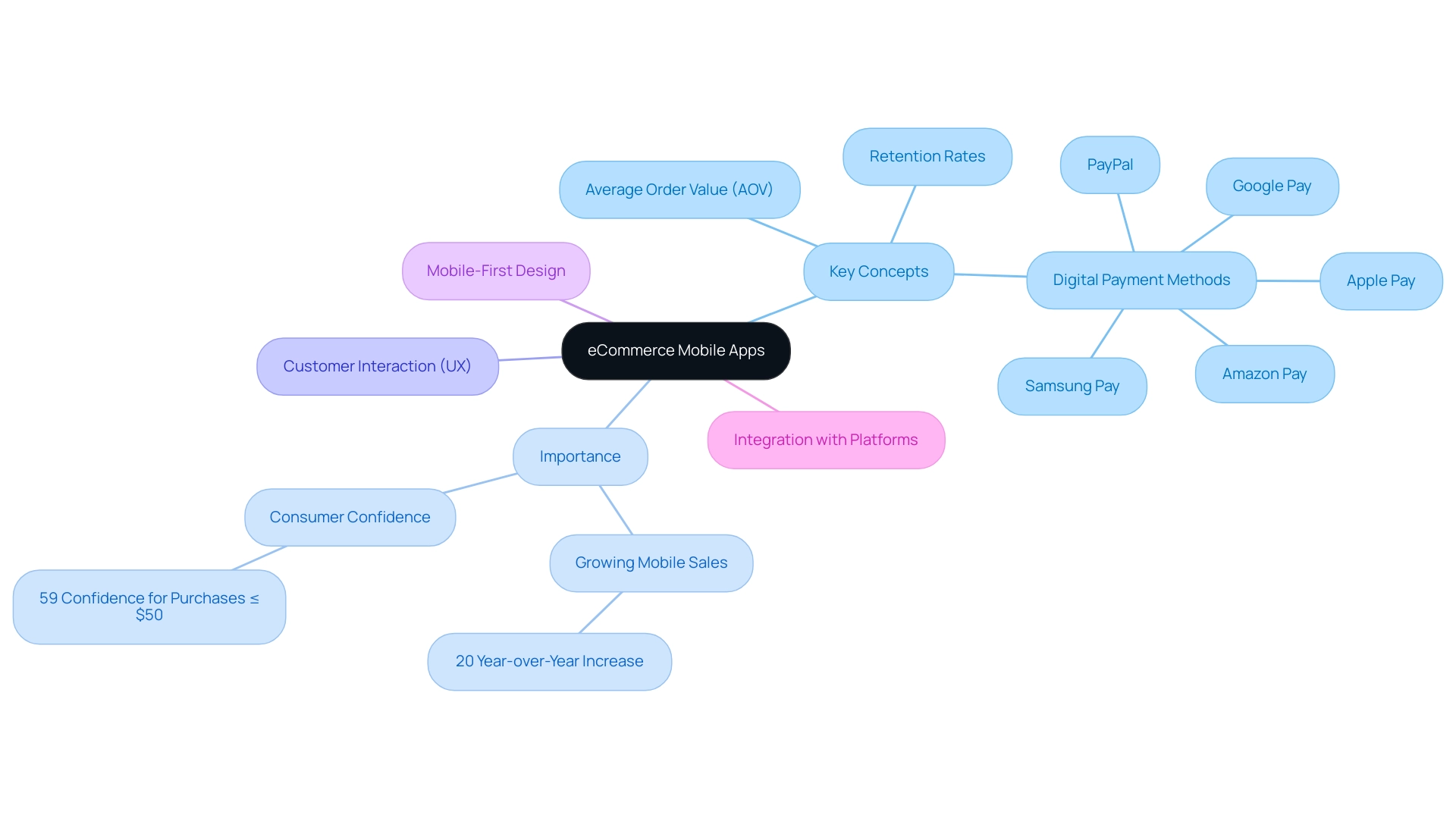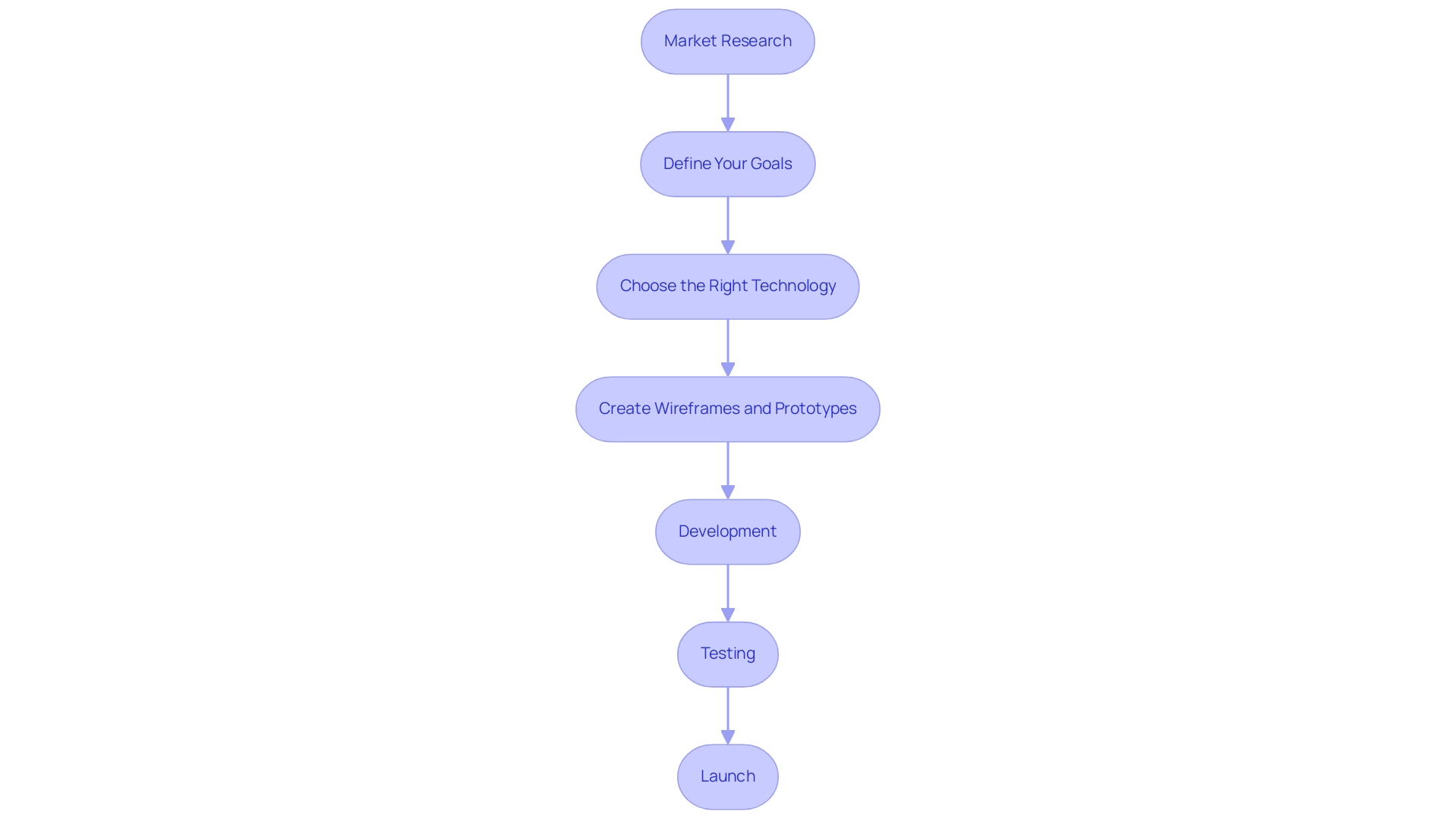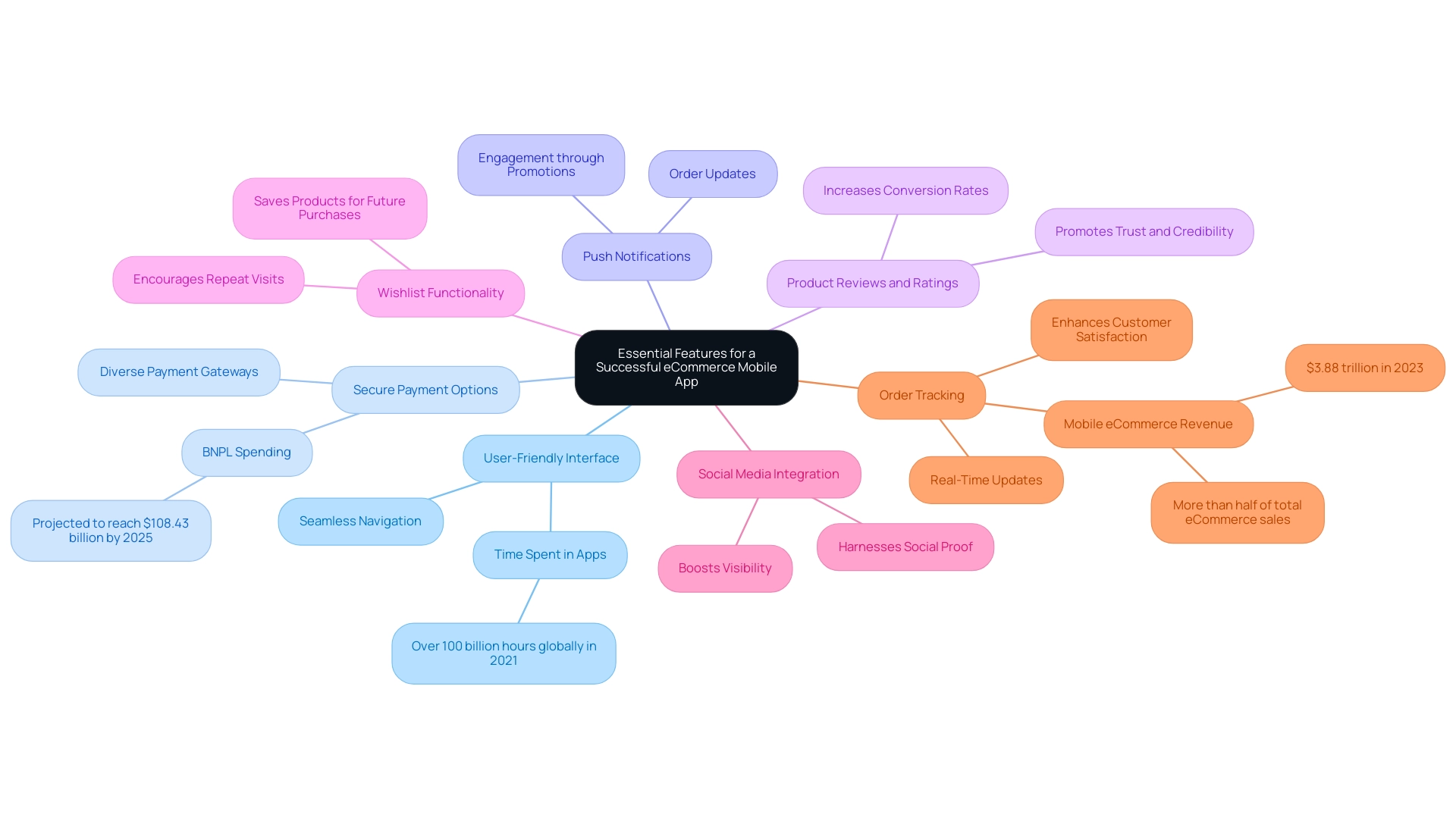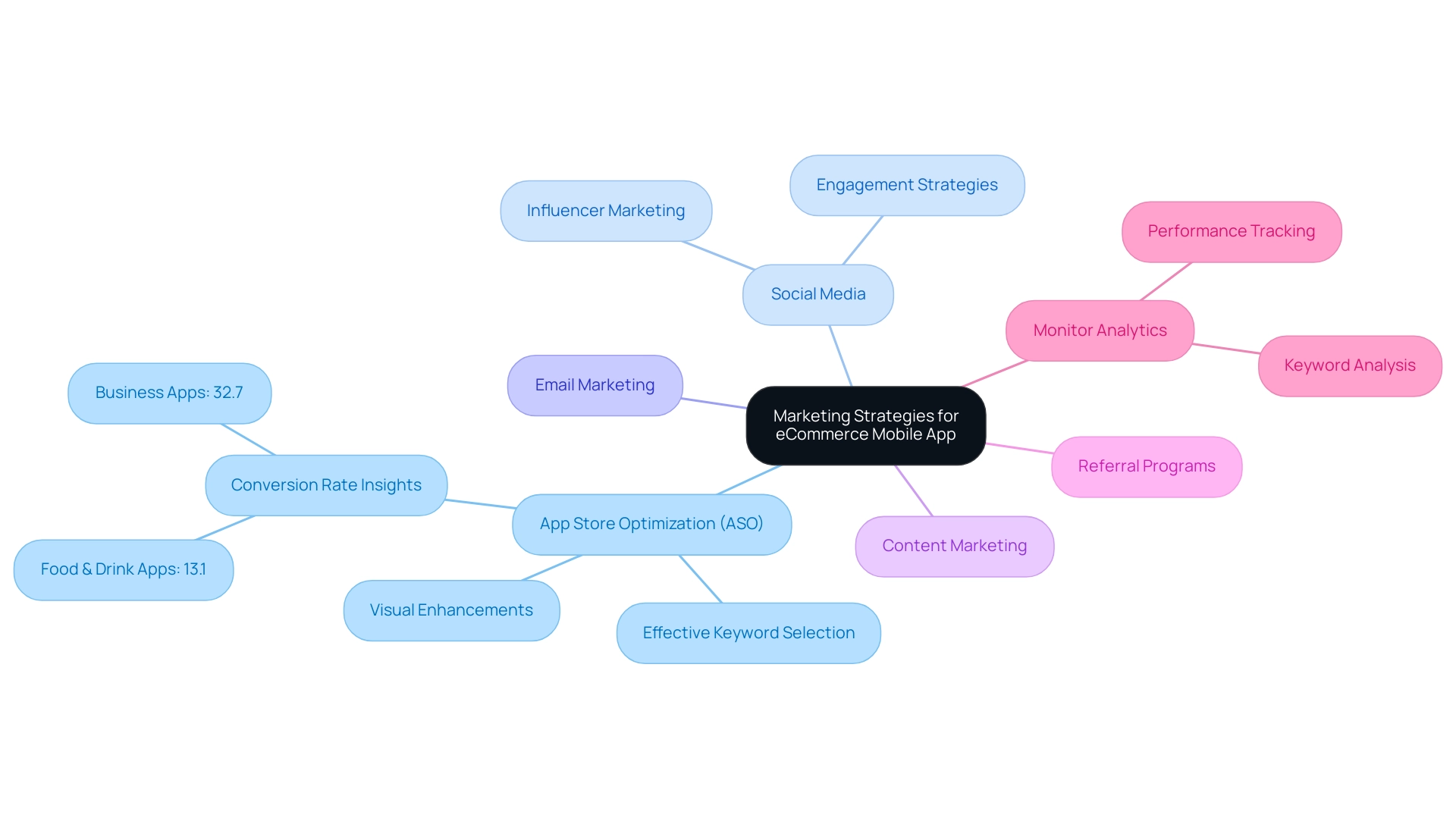Introduction
In the rapidly evolving landscape of digital commerce, eCommerce mobile apps have emerged as essential tools for businesses aiming to enhance customer engagement and streamline the shopping experience. With mobile commerce projected to dominate retail sales, understanding key concepts such as:
- User experience
- Mobile-first design
- Seamless integration with eCommerce platforms
is crucial for success. As consumer confidence in mobile transactions grows, evidenced by significant year-over-year increases in mobile sales, businesses have a unique opportunity to leverage these trends.
This article delves into the fundamentals of developing an effective eCommerce mobile app, highlighting essential features, strategic marketing approaches, and the importance of aligning app functionalities with user needs to drive growth and foster community value.
Understanding eCommerce Mobile Apps: Key Concepts and Importance
eCommerce mobile apps serve as essential instruments designed to simplify the shopping process on handheld devices. With forecasts suggesting that mobile commerce will progressively lead retail sales, understanding ideas like customer interaction (UX), mobile-first design, and seamless integration with eCommerce platforms is vital for success. Our tailored solutions, developed over 20 years of global experience, have a proven track record of enhancing critical KPIs for businesses, including retention rates and Average Order Value (AOV).
These solutions are specifically designed to align with internal goals and KPIs, ensuring that they not only meet the needs of individuals but also foster community value through increased engagement and satisfaction. Recent statistics show that almost 59% of consumers feel assured making purchases of $50 or less on handheld devices, emphasizing a substantial opportunity for businesses to connect with these users effectively. Furthermore, sales through handheld devices have seen a significant 20% year-over-year rise, with an increasing number of individuals opting to shop using their gadgets.
This trend underscores the importance of mobile apps, which have the highest usage rate compared to other app categories. These apps not only promote improved customer interaction through tailored approaches but also provide businesses with essential data insights to enhance their offerings and generate additional revenue. For example, different digital payment methods such as Apple Pay and Google Pay improve the shopping experience by offering convenience and extra rewards for customers.
The convenience and streamlined processes offered by ecommerce mobile apps, along with our dedication to fostering community value, render them essential for driving ecommerce growth in today's digital landscape.

The Step-by-Step Guide to Developing Your eCommerce Mobile App
-
Market Research: A thorough analysis of both competitors and consumer preferences is crucial in identifying market gaps. By leveraging current market research statistics, such as the fact that 43% of eCommerce consumers have experienced payment fraud, businesses can strategically position their apps to address these concerns. Our tailored e-commerce solutions have a proven track record of enhancing key performance indicators (KPIs) and boosting community value by directly addressing these pain points. For instance, implementing secure payment gateways can alleviate consumer concerns about fraud, thereby enhancing trust and engagement. Expert insights, such as those from Business Dasher, indicate that Google Shopping clicks have increased by over 17% annually, underscoring the importance of market trends in app development.
-
Define Your Goals: Establishing clear objectives is foundational for the app's success. Goals may include increasing sales, enhancing customer retention, or addressing specific pain points identified during market research. With over 20 years of experience in reshaping industries, we recommend that a well-defined purpose significantly boosts the app's performance by aligning with internal goals. Additionally, our customized solutions are designed to build incremental revenue by optimizing engagement and conversion rates.
-
Choose the Right Technology: Selecting the appropriate platform—whether iOS, Android, or both—is essential. The technology stack should be robust enough to support the app's functionalities while ensuring scalability. Keeping abreast of the latest technology trends in mobile app development for 2024, such as advancements in AI and AR, can provide a competitive edge and directly enhance the tailored solutions we offer.
-
Create Wireframes and Prototypes: Designing flows and interfaces through wireframes and prototypes helps visualize the app’s layout and functionality. This step encourages cooperation among stakeholders and permits early feedback, which is crucial in enhancing the interface.
-
Development: The coding phase should adhere to established best practices, focusing on performance, security, and overall satisfaction. With the increasing reliance on mobile platforms, ensuring that the app is optimized for speed and security is non-negotiable.
-
Testing: Conducting rigorous testing for bugs and usability issues is essential before launch. Integrating feedback from participants during this phase can result in notable enhancements and a more seamless interaction.
-
Launch: Once the app is ready, deploying it on app stores is just the beginning. Monitoring initial feedback allows for ongoing enhancements and adjustments, ensuring the app remains relevant and effective in meeting consumer needs. This iterative approach will be increasingly important as 33% of businesses without a loyalty program aim to establish one by 2027, reflecting a growing focus on customer retention strategies and highlighting the necessity of loyalty programs in the context of app development.

Essential Features for a Successful eCommerce Mobile App
-
User-Friendly Interface: A seamless navigation process is paramount; products should be clearly categorized to enhance discoverability. The customer experience is critical, as data indicates that time spent in ecommerce mobile apps reached over 100 billion hours globally in 2021, underscoring the necessity for intuitive designs that facilitate easy navigation and product discovery.
-
Secure Payment Options: The integration of diverse payment gateways is essential, including credit cards, digital wallets, and increasingly popular buy now, pay later (BNPL) options. With BNPL spending projected to soar to $108.43 billion by 2025, offering flexible payment methods will cater to evolving consumer preferences and is crucial for capturing a broader customer base.
-
Push Notifications: Tailoring notifications is crucial for engaging individuals. Informing them about promotions, new arrivals, and order updates can significantly enhance customer retention rates.
-
Product Reviews and Ratings: Allowing feedback from individuals and showcasing ratings promotes trust and credibility. Potential buyers are more likely to convert when they see positive reviews from others, making this feature indispensable.
-
Wishlist Functionality: Enabling individuals to save products for future purchases enhances engagement and encourages repeat visits to the app. This feature not only aids in decision-making but also increases the likelihood of conversion later.
-
Social Media Integration: Facilitating product sharing on social platforms boosts visibility and drives traffic back to the app. This integration can harness the power of social proof, which is increasingly influential in the purchasing process.
-
Order Tracking: Providing real-time updates on order status keeps customers informed and reassured throughout their shopping journey. This transparency is crucial for enhancing customer satisfaction and loyalty, particularly as ecommerce mobile apps have driven mobile eCommerce revenue to an astounding $3.88 trillion in 2023, which accounts for more than half of total eCommerce sales. It is clear that these essential features not only contribute to this significant growth but are also necessary for success in the competitive landscape of mobile retail.

Marketing Your eCommerce Mobile App: Strategies for Success
-
App Store Optimization (ASO): Improving visibility in app stores hinges on effective ASO, which involves meticulously optimizing the app description, selecting relevant keywords, and enhancing visuals. This strategy is vital as it can lead to conversion rates that exceed 100%, indicating that many downloads stem from direct search or browse results rather than visiting the app page. Notably, applications from the business domain show a remarkable page view to installation conversion rate of 32.7%, according to insights from AppTweak. Furthermore, ASO techniques should consider that categories like food and drink have a significantly lower conversion rate at 13.1%, highlighting the importance of strategic keyword selection based on category performance.
-
Leverage Social Media: Utilize platforms such as Instagram and Facebook to highlight app features, execute targeted advertising campaigns, and foster engagement with potential clients. Social media serves as a powerful tool in driving awareness and downloads, significantly impacting client acquisition.
-
Influencer Marketing: Partnering with influencers can greatly amplify your reach, allowing your app to connect with a broader audience while leveraging the trust that influencers command through their authentic recommendations. This strategy can enhance credibility and drive adoption.
-
Email Marketing: Develop targeted email campaigns to inform existing customers about your new app. Emphasizing its advantages and distinctive characteristics can effectively transform your existing audience into app adopters, maximizing your marketing efforts.
-
Content Marketing: Create valuable content such as blog posts, videos, or tutorials that showcase the app’s functionality and benefits. This educational approach not only informs potential clients about ecommerce mobile apps but also helps establish your brand as an authority in the eCommerce space.
-
Referral Programs: Implementing referral programs encourages current participants to recommend the app to friends and family. Providing incentives, such as discounts or exclusive content, can significantly enhance participation rates and expand your audience.
-
Monitor Analytics: Employ analytics tools to closely monitor app performance and behavior. Regularly reviewing this data allows for strategic adjustments based on insights, ensuring that marketing efforts remain aligned with user preferences and market trends. Additionally, analyzing the leading keywords searched on the Apple App Store across various countries can provide valuable insights into regional trends, helping to refine ASO strategies further.

Conclusion
eCommerce mobile apps are crucial for businesses aiming to thrive in the expanding mobile commerce landscape. With growing consumer confidence in mobile transactions, focusing on user experience, mobile-first design, and seamless integration with eCommerce platforms is essential for enhancing customer engagement and boosting sales.
The development of a successful mobile app entails several key steps, including:
1. Market research
2. Goal setting
3. Choosing the right technology
Each phase—design, development, and testing—ensures that the app aligns with user expectations. Key features such as:
- A user-friendly interface
- Secure payment options
- Real-time order tracking
are vital for building customer satisfaction and loyalty.
Additionally, effective marketing strategies are necessary to maximize visibility and user acquisition. Utilizing:
- App Store Optimization
- Engaging on social media
- Partnering with influencers
can significantly broaden a business's reach. Regularly analyzing performance metrics allows for timely adjustments to meet evolving consumer preferences.
In conclusion, eCommerce mobile apps represent a significant opportunity for businesses to connect with consumers in a digital-first world. By prioritizing user-centric design, incorporating essential features, and implementing strategic marketing, businesses can excel in the competitive mobile commerce environment and foster lasting customer relationships. Embracing these principles is vital for unlocking the full potential of mobile commerce moving forward.





